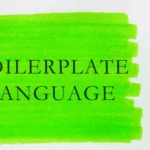Letters of Intent are generally intended to be non-binding documents setting forth the general terms of a prospective transaction between a buyer and seller. The LOI should also contain a roadmap explaining how and when the parties can reach their final agreement.
Well-drafted LOIs also make unambiguous statements that protect the parties from unintended and avoidable consequences if they fail to negotiate and execute a final agreement.
Non-Binding Material Terms
Each of the non-binding terms should be plainly written such that a non-participant can easily understand them. The material terms contain many of the obvious ones: price, payment terms, post-transaction employment for key personnel, customer transition, and buyer’s ownership of equity and property post-closing. The material terms should also include the likely points of contention during negotiations along with proposed resolutions to each of these points.
The non-binding nature of the material terms must be made clearly and repeatedly.
It is important to note LOIs do not contain every potential term that could be in a final agreement. Corporate attorneys must advise and remind their clients (and themselves) the final agreement(s) are the proper place to address ancillary business and legal issues. Souring the interpersonal relationships between negotiating parties through overzealousness is inexcusable.
Binding Terms Specific to the LOI
Certain LOI terms are intended to be binding because they govern the LOI itself, not the contemplated final transaction. These terms include: confidentiality of the LOI and shared information, exclusivity, allocation of costs and expenses, and advance deposits.
A well-crafted LOI clearly states whether any of these terms will survive the expiration or termination of the LOI. In the contrapositive, a well-crafted LOI clearly states none of its LOI-specific provisions will survive if the parties reach a final agreement. This makes sense because either the terms are no longer relevant (i.e., due diligence period) or because they are superseded in the final agreement (i.e., confidentiality)
Pre and Post Transaction Timelines
After executing the LOI, the parties must work together to agree upon the final terms of an agreement. LOIs contain schedules for performance for the parties to either progress toward a final agreement or terminate the LOI. Examples of important dates and time periods include:
- LOI termination and expiration;
- Due diligence response times;
- Due diligence period length;
- Exclusive bargaining period length;
- Contingency periods ( i.e., financing contingency)
- Extension request timing and length of extensions;
- When escrow payments are due and released; and
- When certain calculations must be made for insertion into the final agreement.
LOIs commonly include important dates and time periods concerning important post-transaction dates including:
- payment schedules for notes and earn-out amounts;
- other compensation owed to sellers such as health benefits;
- working capital adjustment and holdback/release dates;
- non-competition and non-solicitation periods for owners and key employees; and
- seller retention as an employee or independent contractor.
To protect the non-binding nature of post-transaction commitments and related schedules, I recommend qualifying each item as “being subject to change after the conclusion of due diligence.” In theory, the parties already understand this point. But the judge or arbitrator resolving any dispute will rely upon such language as proof of the non-binding nature of the LOI.
Important Drafting Tips For Anyone Drafting an LOI
- Determine whether to disclaim the duty to negotiate in good faith. This disclaimer goes beyond simply stating that a party can make decisions in its “sole and absolute discretion.” It governs potential obligations that may arise after the LOI is terminated.
In one well-known Delaware case, the LOI obligated the parties to negotiate and to execute a licensing agreement for certain intellectual property if the parties could not reach a final agreement. The Court enforced this post-LOI obligation because the Buyer reasonably expected to obtain access to the intellectual property unless it engaged in improper conduct. And the Seller would have benefitted by breaching this express term of the LOI.
Your objectives will determine whether to disclaim this duty or to insist upon its inclusion.
- The Non-Binding Nature of the LOI must be repeated numerous times. Many attorneys follow the advice we were given early in our careers: name the agreement a “Non-Binding Letter of Intent” and restate the non-binding nature of the LOI multiple times including in the introductory language and above the signature page.
Although this remains good advice, it is woefully incomplete. The LOI must expressly state no binding agreement exists on the material terms unless and until a final agreement is reached. A New York court recently relied on the absence of this language to rule an LOI containing all of the material terms of a real estate transaction was a binding agreement.
If your client wants to create the appearance of a binding agreement for any reason, then legal counsel must eliminate references to the non-binding nature of the LOI. The primary benefit is the creation of a colorable argument the parties considered the LOI to be a binding agreement in future litigation if necessary.
- Use of “Transaction” Verbs. Certain verbs connote the intention to enter into a binding agreement: offer/accept; commit; and promise. Other words show more work needs to be done before an agreement is reached: intend, expect, and contemplate. Likewise, use of if/then statements must be monitored to determine whether an enforceable obligation automatically arises upon a certain action or event occurring.
Courts will scrutinize word choice, particularly when the LOI states it is the sole documentation of the parties’ positions and obligations.
- Transmittal Letters Must Be Carefully Written. If a transmittal letter suggests the LOI is a final agreement, then the transmittal letter may be used as evidence of the parties’ intention despite the actual language of the LOI. Therefore, the LOI should exclude transmittal letters from governance and interpretation if a dispute arises.
Conclusion
In sharing the ABCs, the goal of this post is to repeat a lesson we all learned in kindergarten: say what you mean and mean what you say.
David Seidman is the principal and founder of Seidman Law Group, LLC. He serves as outside general counsel for companies, which requires him to consider a diverse range of corporate, dispute resolution and avoidance, contract drafting and negotiation, real estate, and other issues. He can be reached at david@seidmanlawgroup.com or 312-399-7390.
This blog post is not legal advice. Please consult an experienced attorney to assist with your legal issues.














